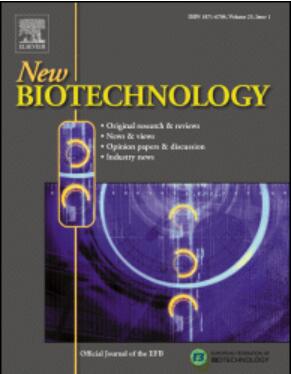未来城市购物中心的美食广场可以为微生物蛋白的生产提供原料。
IF 4.9
2区 生物学
Q1 BIOCHEMICAL RESEARCH METHODS
引用次数: 0
摘要
城市购物中心的美食广场可以成为未来微生物蛋白生产的原料来源。本研究探讨了丝状真菌里氏木霉、各种拟青霉和少孢根霉能否在由橙子皮、软饮料废渣、过期面包或废咖啡渣制备的培养基上培养,这些培养基都是未来食品广场现有的和潜在的副产品。此外,还研究了人造尿液作为未来氮源的描述。侧流预处理促进糖释放高达171gL-1(过期面包)。培养基由经预处理的侧流中添加40gL-1糖制备。添加氮和微量营养素的烧瓶培养增加了真菌生物量。从氮源测试来看,酵母提取物(10gL-1)在软饮料废渣混合物和橘皮汁为基础的培养基中是有效的。对于后者,人工尿液(5gL-1尿素)也起作用。利用实验方法设计进一步优化了这些氮补充物以及pH对生物质产量的影响,并在实验室规模的生物反应器培养中进行了验证。用软饮料废渣或橙皮汁添加酵母浸出物(13 ~ 15gL-1)在生物反应器中培养,可获得良好的生物量,干重可达37.8gL-1和15gL-1,总蛋白质含量可达25%和35%。氨基酸分析显示,人类消费的必需氨基酸分布平衡,证实了未来食品广场的副产品是循环经济中可持续真菌蛋白生产的可行底物。本文章由计算机程序翻译,如有差异,请以英文原文为准。

Future food court in an urban shopping center can supply feedstocks for microbial protein production
Food courts in urban shopping centers can be future sources of feedstock for microbial protein production. This study explored whether filamentous fungi Trichoderma reesei, Paecilomyces variotii and Rhizopus oligosporus can be cultivated on growth media prepared from orange peels, soft drink waste-mix, expired bread or spent coffee grounds, all existing and potential by-products of future food courts. Furthermore, artificial urine to describe human urine as a future nitrogen source was investigated. Side stream pretreatments facilitated sugar releases up to 171 g L−1 (expired bread). Cultivation media were prepared from pretreated side streams with 40 g L−1 sugar. Flask cultivations supplemented with nitrogen and micronutrient increased fungal biomass production. From the nitrogen sources tested, yeast extract (10 g L−1) proved effective in media based on soft drink waste-mix and orange peel juice. For the latter artificial urine (5 g L−1 urea) worked as well. The effects of these nitrogen supplements, along with pH, on biomass production were further optimized using design of experiment methodology and validated in lab-scale bioreactor cultivations. The bioreactor cultivations of P. variotii and T. reesei with soft drink waste-mix or orange peel juice supplemented with yeast extract (13 – 15 g L−1) resulted in good biomass production up to 37.8 g L−1 and 15 g L−1 dry weight with total protein contents reaching 25 % and 35 % for P. variotii and T. reesei, respectively. Amino acid analyses revealed balanced essential amino acid distributions for human consumption, confirming that future food court by-products are viable substrates for sustainable fungal protein production in a circular economy.
求助全文
通过发布文献求助,成功后即可免费获取论文全文。
去求助
来源期刊

New biotechnology
生物-生化研究方法
CiteScore
11.40
自引率
1.90%
发文量
77
审稿时长
1 months
期刊介绍:
New Biotechnology is the official journal of the European Federation of Biotechnology (EFB) and is published bimonthly. It covers both the science of biotechnology and its surrounding political, business and financial milieu. The journal publishes peer-reviewed basic research papers, authoritative reviews, feature articles and opinions in all areas of biotechnology. It reflects the full diversity of current biotechnology science, particularly those advances in research and practice that open opportunities for exploitation of knowledge, commercially or otherwise, together with news, discussion and comment on broader issues of general interest and concern. The outlook is fully international.
The scope of the journal includes the research, industrial and commercial aspects of biotechnology, in areas such as: Healthcare and Pharmaceuticals; Food and Agriculture; Biofuels; Genetic Engineering and Molecular Biology; Genomics and Synthetic Biology; Nanotechnology; Environment and Biodiversity; Biocatalysis; Bioremediation; Process engineering.
 求助内容:
求助内容: 应助结果提醒方式:
应助结果提醒方式:


